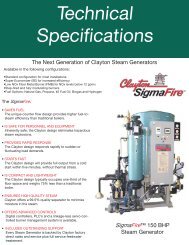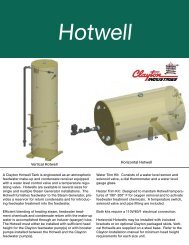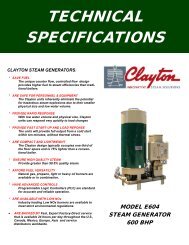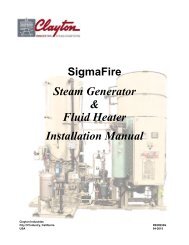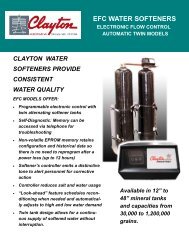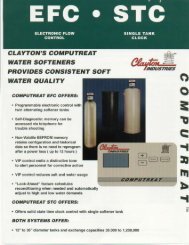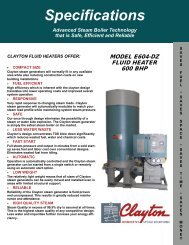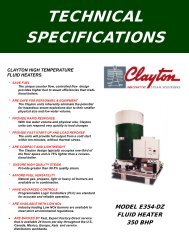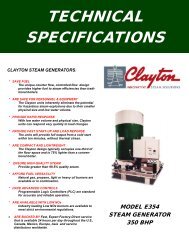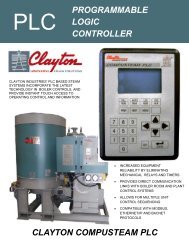Steam Generator Installation Manual - Clayton Industries
Steam Generator Installation Manual - Clayton Industries
Steam Generator Installation Manual - Clayton Industries
You also want an ePaper? Increase the reach of your titles
YUMPU automatically turns print PDFs into web optimized ePapers that Google loves.
<strong>Steam</strong> <strong>Generator</strong> & Fluid Heater<br />
<strong>Installation</strong> <strong>Manual</strong><br />
2.9.1 Supply Side Connections<br />
<strong>Clayton</strong>’s reciprocating PD pumps require that the connection made directly to the pump’s inlet be a<br />
flexible hose section. This hose section should be a bellows-type hose protected by a stainless steel wire<br />
mesh sleeve. It must have at least a 24 inch (61 cm) length with a minimum 18 inch (45.5 cm) long-live<br />
length. This flexible hose section must be appropriately rated to meet the pressure and temperature requirements<br />
of the feedwater supply system. The supply-side piping system must include a pipe anchor directly at<br />
the inlet (hot-well/DA) side of the flexible connector.<br />
2.9.2 Discharge Side Connections<br />
A flexible hose section is required at the reciprocating PD pump discharge outlet whenever it is relocated<br />
from its original, factory-designed, installation location. This hose section should be a bellows-type<br />
hose protected by a stainless steel wire mesh sleeve. It must have at least a 24 inch (61 cm) length with a<br />
minimum 18 inch (45.5 cm) long-live length. Because <strong>Clayton</strong>’s mono-flow heating coil design usually<br />
increases feedwater discharge pressures from <strong>Clayton</strong>’s reciprocating PD pump, this flexible hose section<br />
must be appropriately rated to meet the pressure and temperature requirements of the reciprocating PD pump<br />
output. The flexible hose rating requirements for the discharge will differ from the rating requirements for<br />
the inlet flexible hose section. Contact <strong>Clayton</strong> Engineering for the feedwater pressure of the specific generator<br />
model.<br />
2.10 Pump Suction and Discharge Piping System Design<br />
The suction piping system is a vital area of the piping supply system. Therefore, its design requirements<br />
deserves more careful planning.<br />
2.10.1 General Layout Guidelines<br />
• Lay out piping so no high points occur where vapor pockets may form. Vapor pockets reduce the<br />
effective flow area of the pipe and consequently make pump priming and operation difficult. Vent<br />
any unavoidable high points and provide gauge and drain connections adjacent pump.<br />
• Install eccentric-type pipe reducers when required. Make sure these reducers are installed with the<br />
flat side up.<br />
• Keep piping short and direct.<br />
• Keep the number of turns to a minimum.<br />
• Keep friction losses to a minimum by incorporating smooth fluid flow transitions in the piping layout.<br />
This can be accomplished with long radius elbows, two 45° elbows, or 45° branch laterals<br />
instead of tees.<br />
• DO NOT use <strong>Clayton</strong> equipment for pipe support or pipe anchoring. It is the responsibility of the<br />
installation contractor and the customer to provide adequate and proper pipe supports and anchors.<br />
<strong>Clayton</strong> recommends all steam/fluid heaters, PD feedwater pumps, and water treatment skid pipe<br />
supports and anchors use floor-mounted structural steel.<br />
Sect02_Genrl-xx4_s.fm 2-22 04/21/2015



